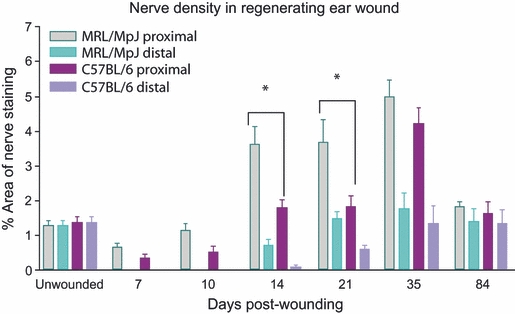Fig. 3.

Comparison of nerve regenerative capacity in both MRL/MpJ and C57BL/6 ear wounds. Mouse ears were wounded with a 2-mm biopsy punch and harvested at days 7, 10, 14, 21, 35 and 84 post-wounding. Immunohistochemistry was used to detect expression of pan-neurofilament within the regenerating blastema-like structure. The density of regenerating nerves within the blastema-like structure of both proximal and distal wound margins was quantified using image-analysis software and expressed as the percentage of the area positively stained. Data shown represent means + SEM, n = 6 for each time-point and strain. There was a significantly higher density of regenerated nerves in the proximal blastema than the distal blastema across the whole experimental time-course in both strains (P<0.01). The MRL/MpJ strain exhibited a period of hyperinnervation in the proximal blastema with a significantly higher nerve density (P<0.05*) at days 14 and 21 compared with C57BL/6, indicating that the MRL/MpJ has an accelerated nerve regenerative capacity in the ear. Nerve density peaks in both the proximal and distal blastema at 35 days post-wounding with both strains showing a similar density. By day 84 nerve density reduced in both strains returning to levels observed in unwounded skin. *Statistically significant.
